Table of Contents
- Introduction: background and context of the problem
- Importance/relevance and extent of the problem
- Evolution (history, current aspects)
- Environmental, social, and economic influences
- Administrative/managerial, legal, ethical, financial implications.
- Current attempts and possible solutions for addressing the problem
- Specific plan and its likelihood of success
- Conclusions
- References
Introduction: background and context of the problem
- Even in today’s world and in a country like the United States, around 44 million people are still uninsured.
- So, who are the uninsured? Less than 15% of the uninsured are children.
- Majority comprise of working families who cannot afford health insurance expenses.
- These includes the immigrants and the minorities as well.
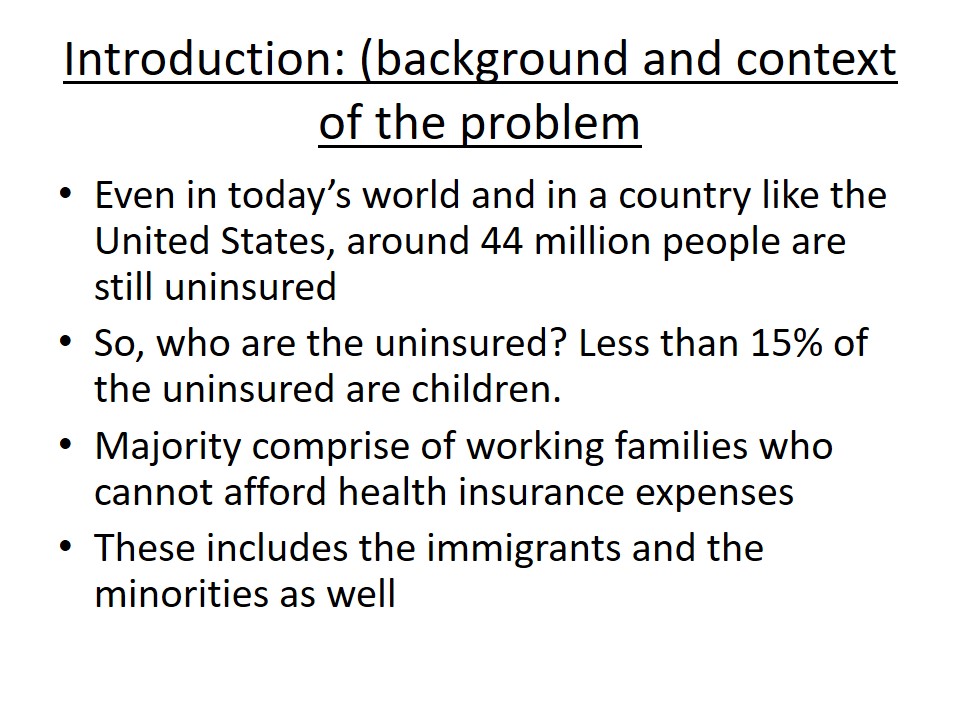
Importance/relevance and extent of the problem
- 44 million Americans are currently uninsured and 60 million are uninsured for either all or part of the year.
- Many of these people have had health insurance but due to massive lay offs, pay cuts, loss of jobs and inflation, can no longer afford health insurance.
- Annual expenditure on the uninsured was calculated to be $125 billion according to Hadley & Holahan.
- When the government is required to pay for the uninsured, it can only do so to a certain extent because it has a limit to the subsidy it can allot to healthcare expenditure.
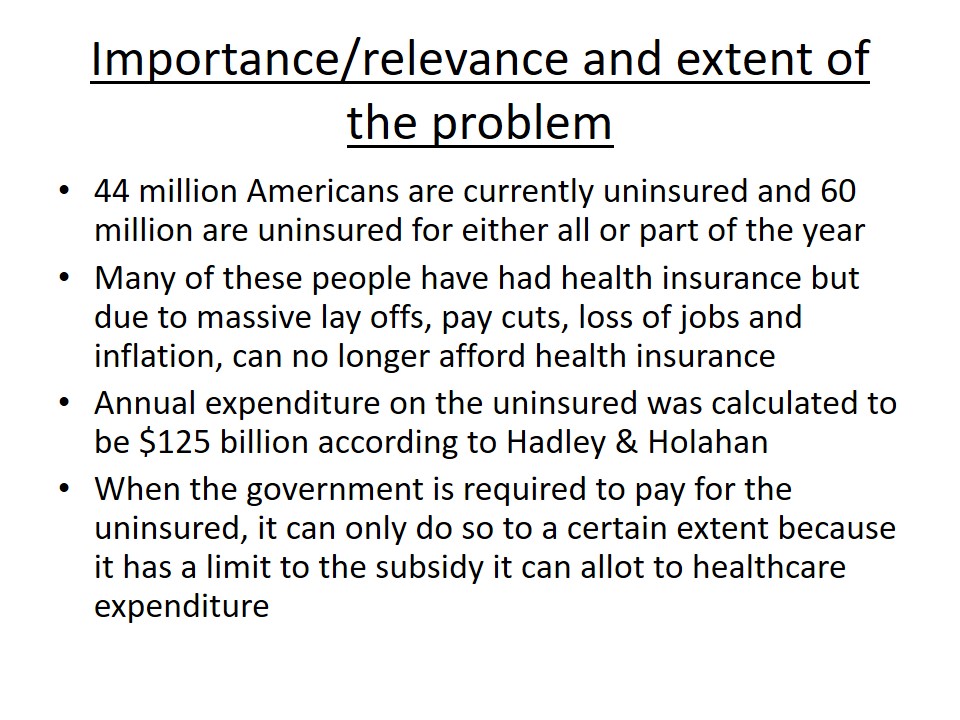
Evolution (history, current aspects)
- The history of people being uninsured in the US is directly linked with its causes.
- Immigrants that come in have little or no money and take up low paying jobs and cannot afford health insurance.
- It is also reported that the economic downturn has played a major role in the numbers of the uninsured.
- Experts say that with an inflation rate of just 1%, the population increase in the uninsured segment has increased by 1.1 million.
- A major 56% of the uninsured population is uninsured because of the lack of finances to afford it.
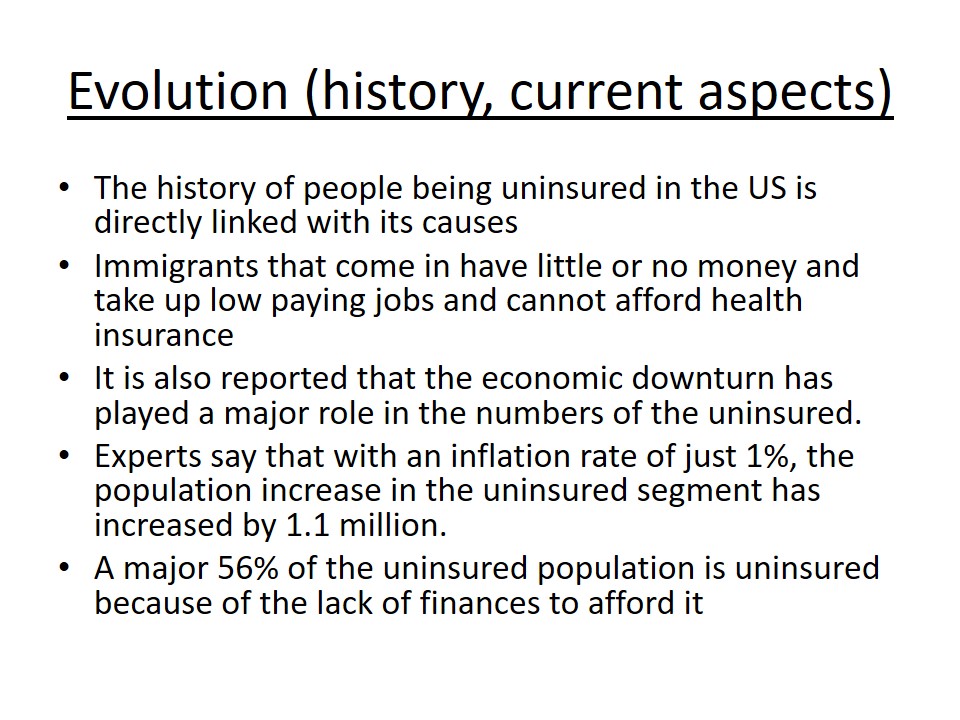
Environmental, social, and economic influences
- Economic:
- The uninsured statistics are significantly affected by economic forces among many.
- Families with a household income of less than $30,000 are 4.5 times more likely to not have health insurance than families in the household income bracket of over $60,000.
- Social:
- The biggest social factor affecting the issue is the issue of race and ethnicity
- Studies showed that Asian citizens of the US had a higher percentage of people without health insurance.
- Most of these people little education and could not speak fluent English.
- This forms a communication barrier and restricts access to facilities.
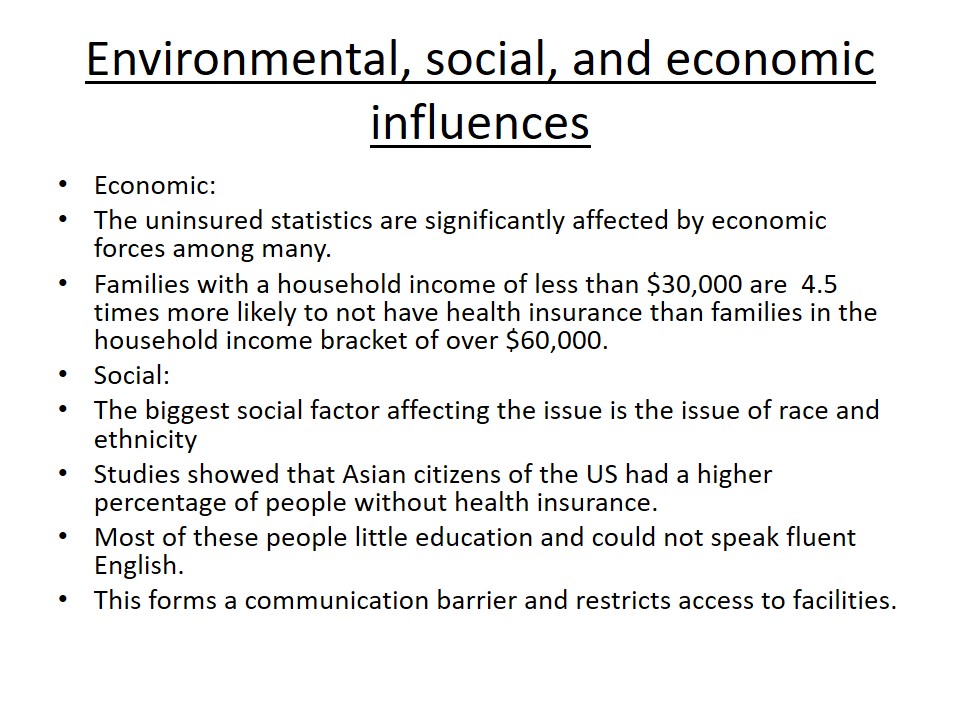
Administrative/managerial, legal, ethical, financial implications.
- Administrative:
- The biggest concern is the reformation of healthcare policies and redirection of federal funds.
- Discount fee negotiation with healthcare providers is a necessity because the growing number of uninsured people is mainly due to financial issues
- Managerial:
- Healthcare organizations are promoting the benefits of insurance by highlighting the negatives of not having insurance and communicating the benefits of insurance
- Financial:
- Around 15% of the US GDP is spent on medical expenditure
- Costs of uninsured are usually covered through a system of shared costs which means portions of high insurance premiums, charity or tax money is usually consumed in this area.
- Ethical:
- The healthcare organizations are in a position where they can exploit these uninsured ‘subjects’ for various purposes.
- Healthcare providers also face ethical dilemmas and have to choose between providing further medical treatment to patients when needed, knowing that the patient is not insured and would not be able to cover the treatment expenses.
- Legal:
- The greatest legal implications revolve around the issue of eligibility
- Certain amendments were made including The Personal Responsibility and Work Opportunity Reconciliation Act restricted coverage to people who have not lived in the US for at least five years plus any undocumented children and people
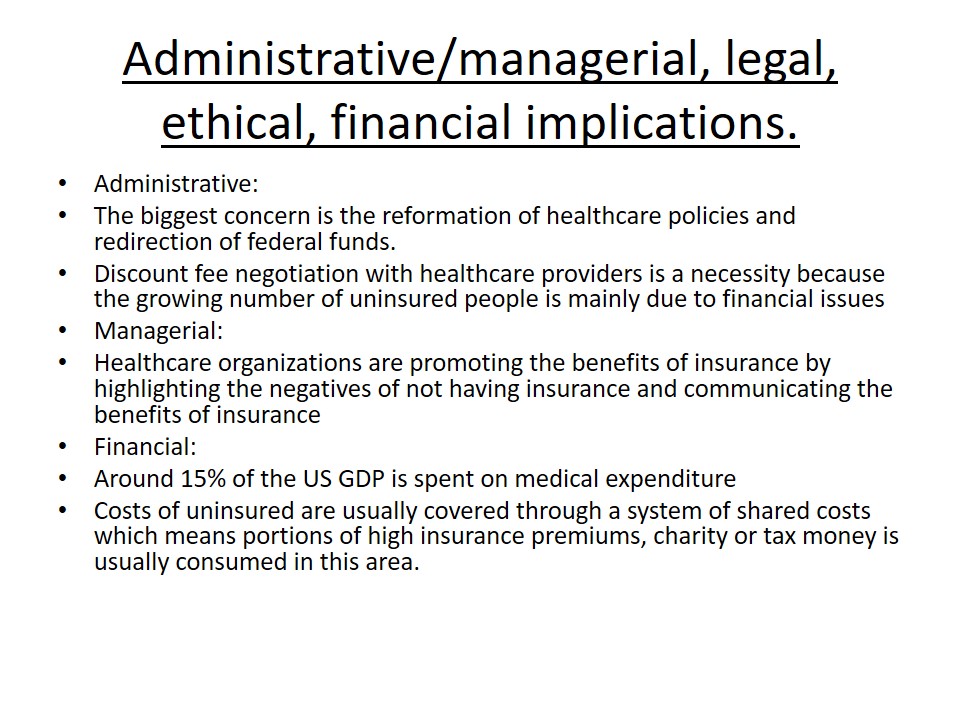
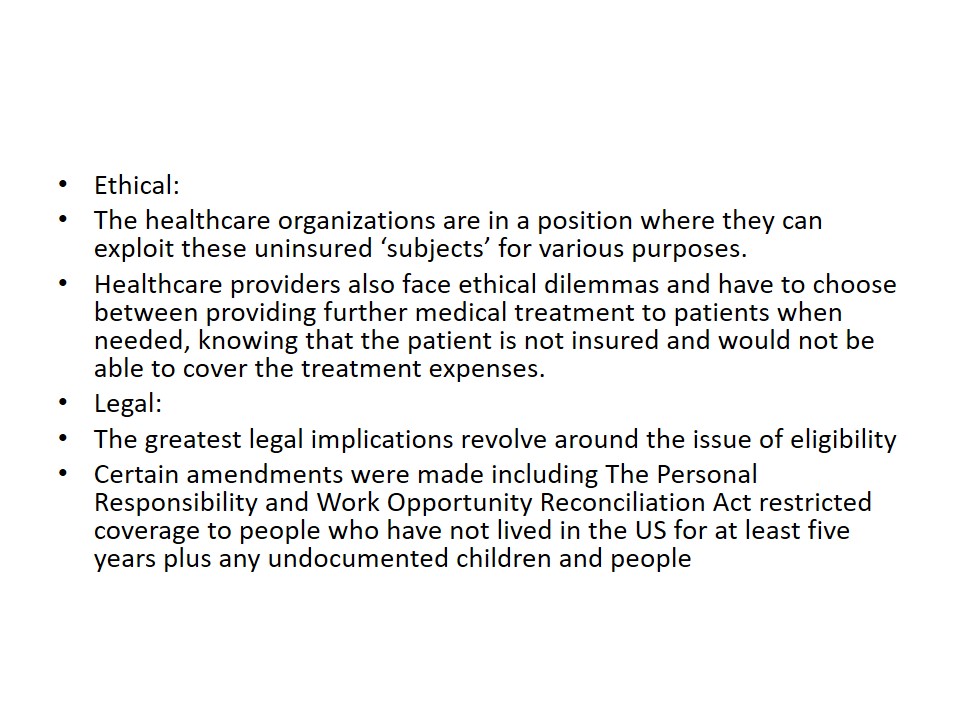
Current attempts and possible solutions for addressing the problem
- The new US administration is focusing on higher discount rates from drug companies to medical insurance providers.
- Redirection of federal funds is being proposed with the idea of funding medical research and financing the insurance providing pool for the public.
- Expenditure is being incurred on outreach programs that help the issue of immigrants and minority uninsured people.
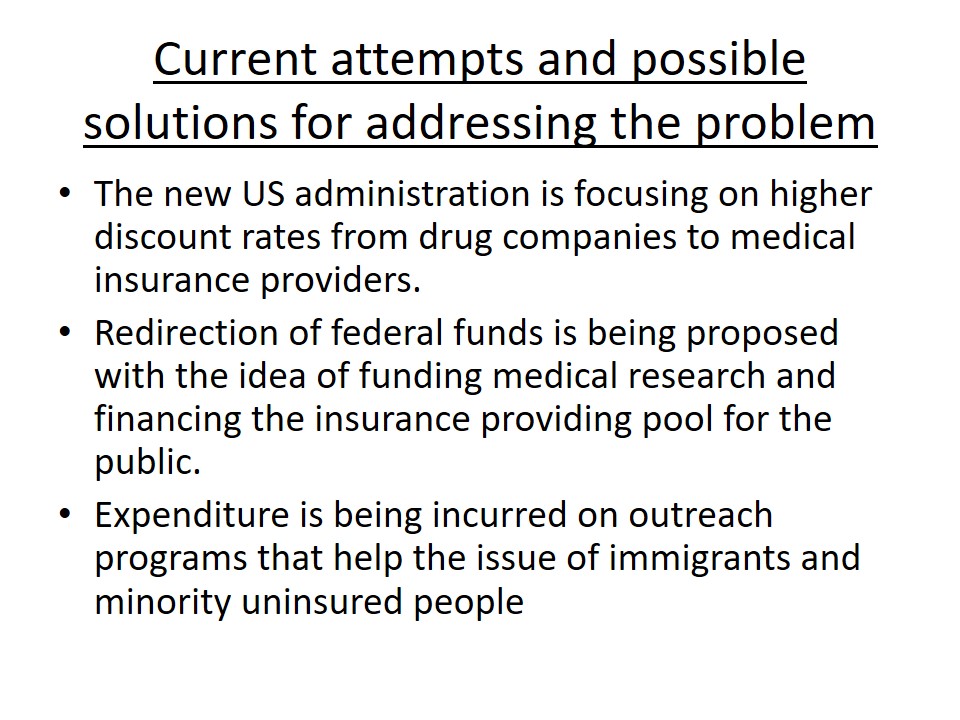
Specific plan and its likelihood of success
- A good plan to start off the solution chain for this problem would be the proper reallocation of federal funds in favor of healthcare research and insurance coverage.
- At the same time, the US administration needs to implement a single publically funded pool and provide health insurance for all US.
- If implemented, the plan will ensure equality and healthcare surety for all US citizens.
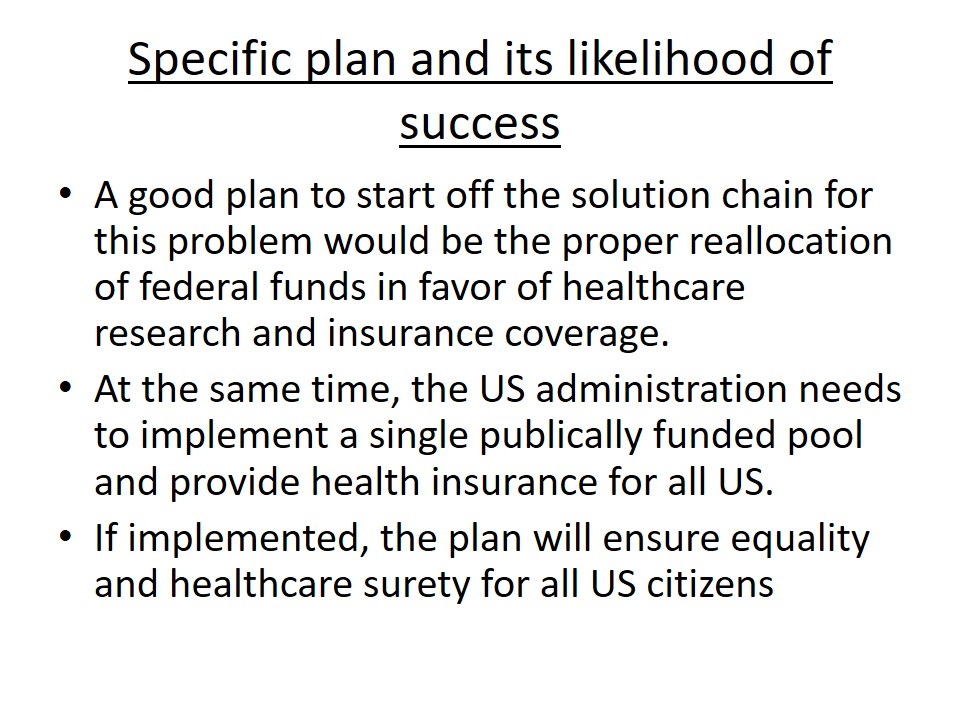
Conclusions
- The uninsured situation has been increasing, fueled by the economic downturn and the financial crisis the people are facing.
- Cultural and ethnic differences affect the problem as well.
- With the right funding, the situation can be improved.
- For an overall permanent solution, one large publically financed pool can be a fair and widespread solution.
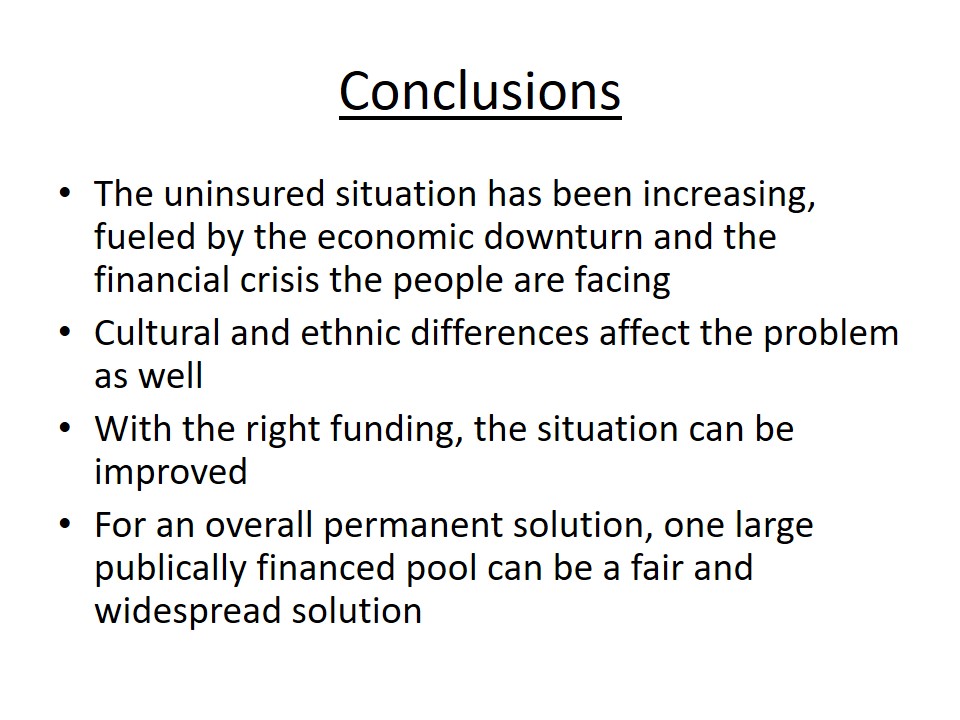
References
- Byrd, W. & Clayton, L. An American Health Dilemma: Race, medicine, and health care in the United States 1900-2000. Published by Routledge. (2002).
- Hadley, J. & Holahan, J. “The Cost of Care for the Uninsured: What Do We Spend, Who Pays, and What Would Full Coverage Add to Medical Spending?” Kaiser Commission on Medicaid and the Uninsured. Web.
- Blustein, J. (2005). One Nation, Uninsured: Why the U.S. Has No National Health Insurance.. New England Journal of Medicine, 353(7), 743-744. Web.
- “ONE NATION, UNINSURED: Why the U.S. Has No National Health Insurance.” Kirkus Reviews 73.4 (2005): 218-218. Academic Search Premier. EBSCO. Web.
- Rob Varnon. “Many arguments, few solutions to growing problem of uninsured Americans.” Connecticut Post (Bridgeport, CT) (n.d.). Newspaper Source. EBSCO. Web.